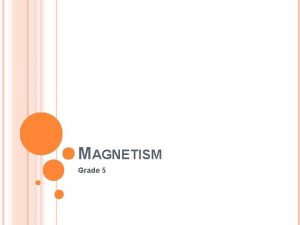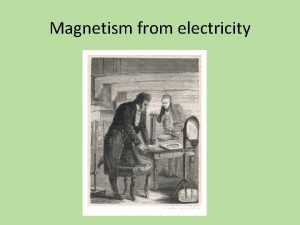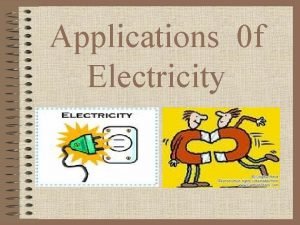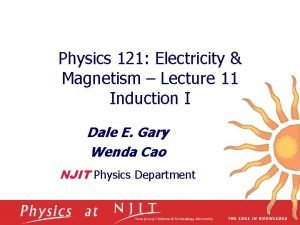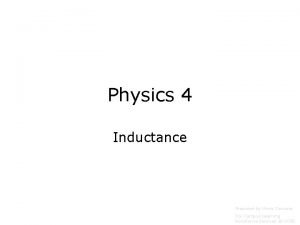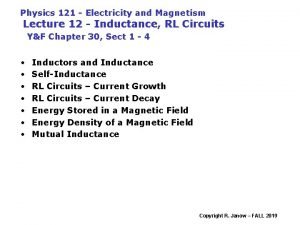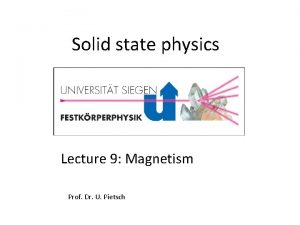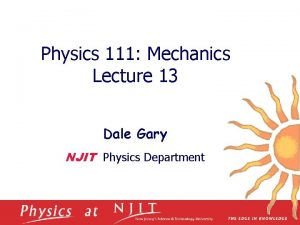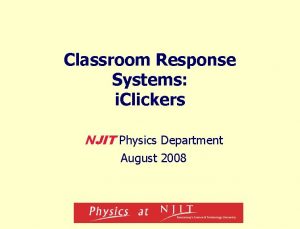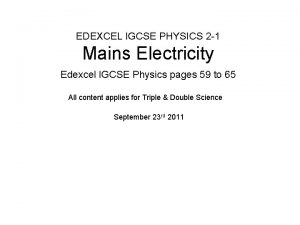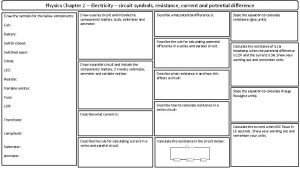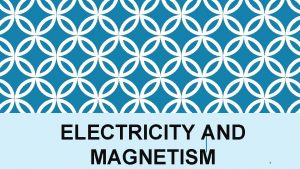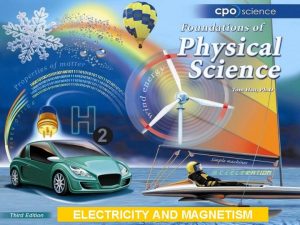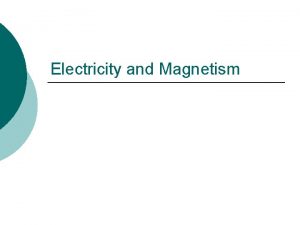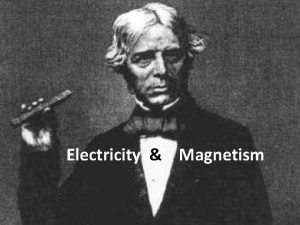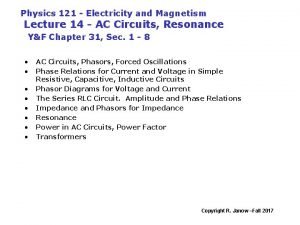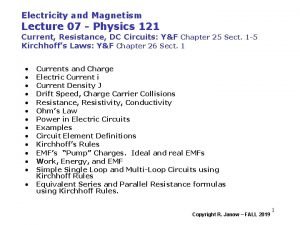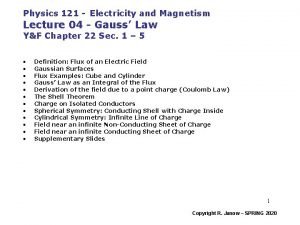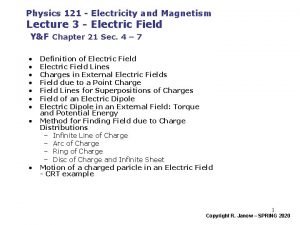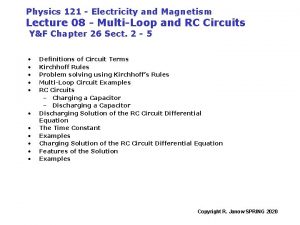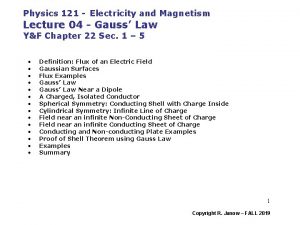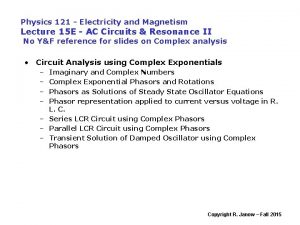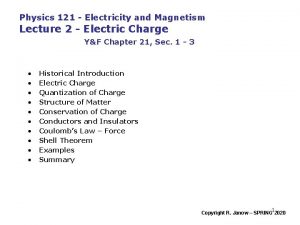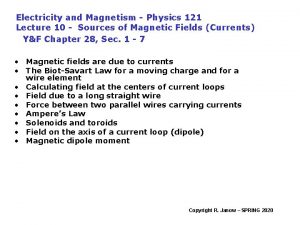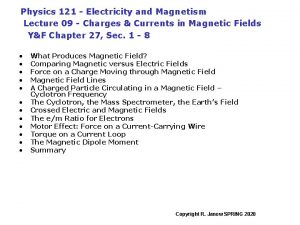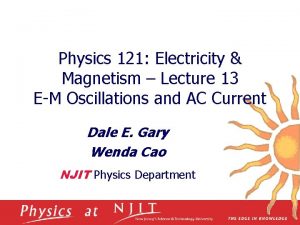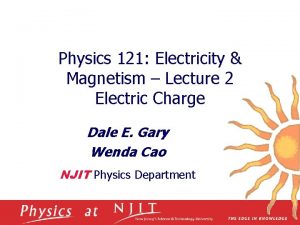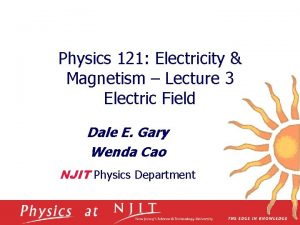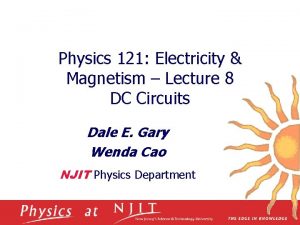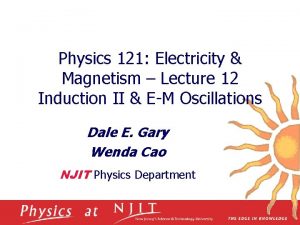Physics 121 Electricity and Magnetism Lecture 12 Inductance
























- Slides: 24

Physics 121 - Electricity and Magnetism Lecture 12 - Inductance, RL Circuits Y&F Chapter 30, Sect 1 - 4 • • Inductors and Inductance Self-Inductance RL Circuits – Current Growth RL Circuits – Current Decay Energy Stored in a Magnetic Field Energy Density of a Magnetic Field Mutual Inductance Copyright R. Janow – FALL 2019

Changing magnetic flux directly induces electric fields Mutual Inductance Example <–> Simple Transformer conducting loop, resistance R A thin solenoid, n turns/unit length • Solenoid cross section A • Zero B field outside solenoid • Field inside solenoid: Flux through the wire loop: Changing current i changing flux EMF is induced in wire loop: Bind Current induced in the loop is: If di/dt is positive, B is growing, then Bind opposes change and i’ is counter-clockwise What makes the induced current i’ flow, outside solenoid? • • • B = 0 outside solenoid, so it’s not the Lorentz force d. F/dt within the loop directly induces an electric field Eind causes current to flow in the loop Eind is there even without the wire loop (no current flowing) Electric field lines are loops that don’t terminate on charge. Eind is non-conservative as the line integral (potential) around a closed path is not zero [Generalized Faraday’s Law]. Copyright R. Janow – FALL 2019

FARADAYS LAW EFFECTS IN COILS - MUTUAL and SELF INDUCTANCE Mutual-induction between coils: di 1/dt in “primary” produces E field that induces current i 2, EMF, and induced B field in “linked” secondary coil (transformer principle). N Self-induction includes same effects in a single coil: • Changing current di/dt in a single coil generates changing magnetic flux in the interior of the coil. • Changing magnetic flux induces electric field in & near the coil, • which drives extra current to flow in the coils turns of wire. • That induced current in turn creates “induced magnetic flux/field” opposed to the change in flux through the coil. • The integral of the induced E field generates the “back EMF” opposing or sustaining the applied current in the coil. • For increasing current, “back” EMF limits the rate of current increase • For decreasing current, “back” EMF sustains the current (limits decrease) Inductance measures EMF opposed to the rate of change of current Eind = - L di/dt L is the inductance Copyright R. Janow – FALL 2019

Definition: Calculating Self-inductance Recall capacitance: depends only on geometry It measures charge stored per volt Self-inductance depends only on coil geometry It measures flux created per ampere number of turns self-inductance Joseph Henry 1797 – 1878 flux through one turn depends on current & all N turns cancels current dependence in flux above SI unit of inductance: Does this definition make sense? Cross-multiply……. Take time derivative • L contains all the geometry • EL is the “back EMF” Another form of Faraday’s Law! Copyright R. Janow – FALL 2019

Example: Find the Self-Inductance of a solenoid Field: + - L RL where ALL N turns contribute to self-flux through ONE turn Flux in just one turn: Apply definition of self-inductance: § N turns § Area A § Length l § Volume V = Al • Depends on geometry only, like capacitance. • Proportional to N 2 ! Check: Get same formula for L if you start with Faraday’s Law for FB: for solenoid use Note: Inductance per unit length has same dimensions as m 0 above Copyright R. Janow – FALL 2019

Example: calculate self-inductance L for an ideal solenoid l Ideal inductor uses ideal solenoid abstraction: Non-ideal inductors have internal series resistance: r L · VIND = EL - ir = measured terminal voltage · Direction of ir depends on current · Direction of E depends on di/dt L · Constant current implies , induced voltage EL = 0 Inductor behaves like a wire with resistance r Vind Copyright R. Janow – FALL 2019

Implication for circuits: Lenz’s Law controls Back EMF across Inductors i + If i is increasing: EL Di / Dt EL opposes increase in i - Power is being stored in B field of inductor i If i is decreasing: Di / Dt EL EL opposes decrease in i + Power is being tapped from B field of inductor What if CURRENT i is constant (steady state)? EL = 0, inductance acts like a simple wire Copyright R. Janow – FALL 2019

Induced EMF in an Inductor 12 – 1: Which statement describes the current through the inductor below, if the induced EMF is as shown? A. B. C. D. E. Rightward and constant. Leftward and constant. Rightward and increasing. Leftward and decreasing. Leftward and increasing. Copyright R. Janow – FALL 2019

Example: Current I increases uniformly from 0. 0 to 1. 0 A. in 0. 1 seconds. Find the induced voltage EL (back EMF) across a 50 m. H (milli-Henry) inductance. + i EL means that current is increasing and to the right i Apply: Substitute: Negative result means that induced EMF is opposed to both di/dt and i. Inductors are Devices: • • • Inductors, sometimes called “coils”, are common circuit components. Insulated wire is wrapped around a core. They are mainly used in AC filters and tuned (resonant) circuits. Copyright R. Janow – FALL 2019

Inductors in Circuits—The RL Circuit Basic series RL circuit: • Time-dependent results are reminiscent of RC circuit. • • A battery with EMF E drives a current around the loop. Changing current produces a back EMF or a sustaining EMF EL in the inductor. Task: Derive circuit equations using Kirchhoff’s loop rule. Convert to differential equations and solve (as for RC circuits). New term for Kirchhoff Loop Rule: When traversing an inductor in the same direction as the assumed current insert: Voltage drops by EL for growing current Copyright R. Janow – FALL 2019

Series LR circuit i E a R + - b L • Inductance & resistance + EMF • Find time dependent behavior • Use Loop Rule EL i NEW TERM FOR KIRCHHOFF LOOP RULE Given E, R, L: Find i, EL, UL for inductor as functions of time Growth phase, switch to “a”. Loop equation: Decay phase, switch to “b”, exclude E, Loop equation: • At t = 0, current grows rapidly but i = 0, EL= -E • L acts like a broken wire, blocks current flow • Later: Current is clockwise and growing. EL opposes E. • As t infinity, current is large but stable, di/dt 0 • Back EMF EL 0, i E / R, • L acts like an ordinary wire • Energy is stored in B field within L & dissipated in R • Energy stored in L will be dissipated in R • EL acts like a battery maintaining previous current • At t = 0 current i = E / R, unchanged, CW • Later: current begins to collapse • As t infinity current 0. Copyright Energy is depleted R. Janow – FALL 2019

LR circuit: decay phase solution R • After growth phase equilibrium, switch from a to b, battery out. • Current i 0 = E / R initially still flows CW through R • EMF EL tries to maintain current using stored energy • Polarity of EL is reversed versus growth. Eventually EL 0 Loop Equation is : - b EL L + i Circuit Equation: di/dt <0 during decay, opposite to current Substitute : • First order differential equation with simple exponential decay solution • At t = 0+: large current implies large di / dt, so EL is large (now driving current) • As t infinity: current stabilizes, di / dt and current i both 0 Current decays exponentially: i 0 i EMF EL and VR also decay exponentially: t t 2 t 3 t Compare to RC circuit, decay Copyright R. Janow – FALL 2019

LR circuit: growth phase solution Circuit Equation: Loop Equation is : Substitute : • First order differential equation again - saturating exponential solutions • At t = 0: current is small because di / dt is large. Back EMF opposes battery. • As t infinity: current stabilizes at iinf = E / R. di / dt approaches zero, Current starts from zero, grows as a saturating exponential. iinf i • i = 0 at t = 0 in above equation di/dt = E/L fastest rate of change, largest back EMF Back EMF EL decays exponentially t t 2 t 3 t Compare to RC circuit, charging Voltage drop across resistor VR= -i. R Copyright R. Janow – FALL 2019

Example: For growth phase find back EMF EL as a function of time S Use growth phase solution + At t = 0: current = 0 - Back EMF is proportional to rate of change of current At t = 0, EL equals the battery potential § i. R drop across R = 0 § L acts like a broken wire at t = 0 i EL -E After a very long (infinite) time: § Current stabilizes, back EMF=0 § L acts like an ordinary wire at t = infinity Copyright R. Janow – FALL 2019 EL

Current through the battery - 1 12 – 2: The three loops below have identical inductors, resistors, and batteries. Rank them in terms of current through the battery just after the switch is closed, greatest first. A. I, III. B. II, I, III. C. III, I, II. D. III, I. E. II, I. III. Hint: what kind of wire (ordinary or broken) does L act like? Copyright R. Janow – FALL 2019

Current through the battery - 2 12 – 3: The three loops below have identical inductors, resistors, and batteries. Rank them in terms of current through the battery a long time after the switch is closed, greatest first. A. B. C. D. E. I, III. II, I, III, I, II. III, I. III. Hint: what kind of wire (ordinary or broken) does L act like? Copyright R. Janow – FALL 2019

Energy stored in inductors Recall: Capacitors store energy in their electric fields derived using p-p capacitor Inductors also store energy, but in their magnetic fields Magnetic Potential Energy – consider power into or from inductor derived using solenoid • UB grows as current increases, absorbing energy • When current is stable, UB and u. B are constant • UB decreases as current decreases. It powers the persistent EMF during the inductor’s decay phase R. Janow – FALL 2019 • The B field stores energy with or without Copyright a conductor

Example: How much energy is stored in the magnetic field of an inductor after a growth phase? a) At equilibrium (infinite time) how much energy is stored in the coil? E = 12 V L = 53 m. H b) How long (tf) does it take to store 25% of this energy? take natural log of both sides Copyright R. Janow – FALL 2019

Mutual Inductance • Example: a pair of co-axial, flux-linked coils • di 1/dt in the first coil induces current i 2 in the second coil, in addition to self-induced effects. • M 21 depends on geometry only, as did L, C, and R • Changing current in primary (i 1) creates E field that drives current, induced flux and EMF through coil 2 Definition: number of turns in coil 2 mutual inductance cross-multiply time derivative flux through one turn of coil 2 due to all N 1 turns of coil 1 current in coil 1 • M 21 contains all the geometry • E 2 is EMF induced in 2 by 1 Another form of Faraday’s Law! The linked flux is the same (smaller coil) if coils reverse roles, so…. . proof not obvious Copyright R. Janow – FALL 2019

Example: Calculating the mutual inductance M Larger coil (#1) is a flat loop of N 1 turns (not a solenoid) PRIMARY larger coil 1 N 1 turns radius R 1 Assume uniform B Use arc formula with f=2 p SECONDARY smaller coil 2 N 2 turns radius R 2 Flux through one turn of flat smaller coil (#2) depends on B 1 and smaller area A 2 Changing current i 1 in loop 1 induces E 2 in loop 2: smaller radius (R 2) determines the linkage Summarizing results for mutual inductance: Copyright R. Janow – FALL 2019

SUPPLEMENTARY MATERIAL Copyright R. Janow – FALL 2019

Summarizing RL circuits growth phase • When t / t. L is large: • When t / t. L is small: • The current starts from zero and increases up to a maximum of with a time constant given by Extra Inductor acts like a wire. i = 0. Inductor acts like an open circuit. Inductive time constant Compare: Capacitive time constant • The voltage across the resistor is proportional to current • The voltage across the inductor is Copyright R. Janow – FALL 2019

Summarizing RL circuits decay phase Extra The switch is thrown from a to b Kirchoff’s Loop Rule for growth was: • Now it is: • The current decays exponentially: • Voltage across resistor also decays: • Voltage across inductor: VR (V) • Copyright R. Janow – FALL 2019

Example: Air core Transformer - Concentric coils OUTER COIL – IDEAL SOLENOID • Coil diameter D = 3. 2 cm • nouter = 220 turns/cm = 22, 000 turns/m • Current iouter falls smoothly from 1. 5 A to 0 in 25 ms • Field uniform across outer coil is: FIND INDUCED EMF IN INNER COIL DURING THIS PERIOD • Coil diameter d = 2. 1 cm =. 021 m, Ainner = p d 2/4, short length • Ninner = 130 turns = total number of turns in inner coil Direction: Induced B is parallel to Bouter which is decreasing Would the transformer work if we reverse the role of the coils? Copyright R. Janow – FALL 2019
 Electricity and magnetism lecture notes
Electricity and magnetism lecture notes 4 forces of nature
4 forces of nature Ib physics topic 5 question bank
Ib physics topic 5 question bank Electricity and magnetism jeopardy
Electricity and magnetism jeopardy Sph3u electricity and magnetism
Sph3u electricity and magnetism Electromagnet experiment hypothesis
Electromagnet experiment hypothesis Magnetic susceptibility formula
Magnetic susceptibility formula Grade 5 electricity and magnetism
Grade 5 electricity and magnetism Electricity and magnetism
Electricity and magnetism Electricity and magnetism
Electricity and magnetism Electricity and magnetism
Electricity and magnetism Electricity and magnetism
Electricity and magnetism Electricity and magnetism
Electricity and magnetism Magnetism vocabulary
Magnetism vocabulary Static electricity and current electricity
Static electricity and current electricity Current electricity gif
Current electricity gif What is inductance in physics
What is inductance in physics Emf in inductor
Emf in inductor Magnetism
Magnetism Conceptual physics magnetism
Conceptual physics magnetism Kepler njit
Kepler njit Njit physics
Njit physics Igcse physics electricity questions and answers
Igcse physics electricity questions and answers 01:640:244 lecture notes - lecture 15: plat, idah, farad
01:640:244 lecture notes - lecture 15: plat, idah, farad Physics circuit symbols
Physics circuit symbols







